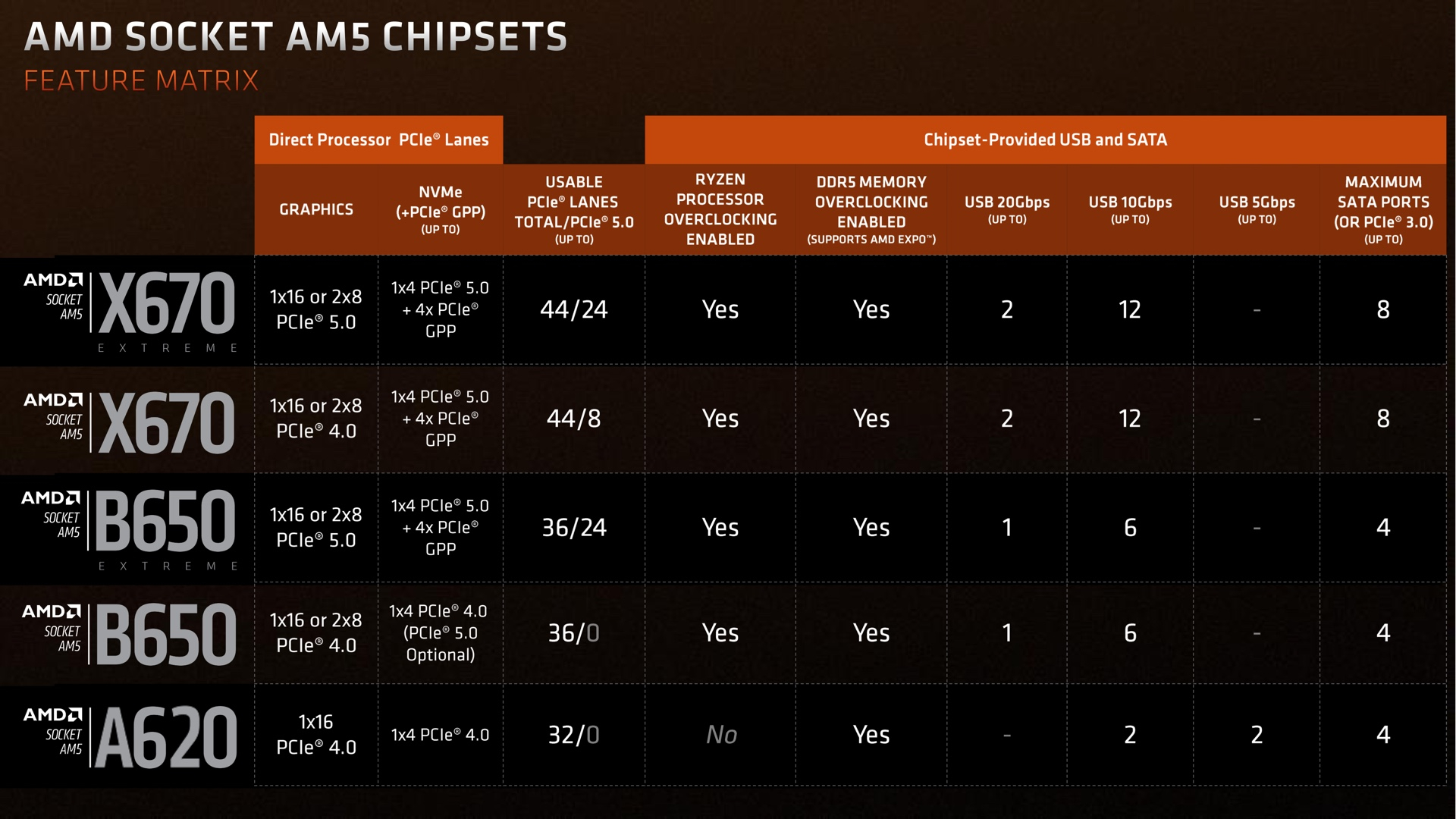AMD’s cheap new motherboards are exactly what PC gamers need right now
AMD is making PC gaming cheaper, but I think there’s more work to be done

Despite their stellar gaming performance, AMD’s next-gen Ryzen 7000 processors have remained largely out of reach for PC gamers – especially those on a budget. But things could be about to change for the better.
The reason for this inaccessibility is twofold: for starters, the CPUs themselves aren’t exactly cheap. The new flagship of the AMD Ryzen line, the awesomely powerful Ryzen 9 7950X3D, costs a hefty $699 / £750 / AU$1,139. Meanwhile, the most affordable chip in the new lineup (the Ryzen 5 7600X) is a more realistic $299 / £320 / AU$489 – though you can usually pick one up for less than that.
That latter price isn’t insurmountable for PC gamers, but it’s the second reason that has caused real problems: the Ryzen 7000 chips are some of the best processors around, but they require the new AM5 motherboard socket, which means upgrading your board to a newer model. It gets worse, too: those new mobos only accept DDR5 RAM, so you’ll be shelling out for a system memory upgrade, too.
Up until now, the only motherboards you could buy that featured the new AM5 socket were those with X670 and B650 chipsets. While the latter are a bit more affordable than the higher-end X670 boards, they’re still not exactly cheap: the lowest price we could find on Newegg.com was $129.99, for a decidedly stripped-down Gigabyte B650M K motherboard.
Most B650 mobos sit within the $150-$200 range; factor in the cost of new DDR5 memory too, and you’re looking at a high minimum spend to upgrade or build an entirely new Ryzen 7000 gaming PC.
A challenger approaches
Have no fear, though: there’s a new kid on the block. AMD quietly announced a new motherboard chipset last week, the entry-level A620 variant. While few of these boards are available to buy right now, AMD is confident that the new chipset will bring down the price of access to Ryzen 7000, with prices starting at $85.
That’s pretty darn cheap! I’m glad to see it; AMD’s new CPUs are brilliant for gaming, and the barrier to entry has been a definite source of frustration. My own gaming PC at home runs on a Ryzen 5000 processor, and the cost of upgrading has certainly given me pause whenever I’ve considered stepping up to 7000.
Now, the A620 chipset naturally has some limitations to keep the pricing low (and that $85 price mark AMD stated was no joke: you can get an ASRock A620M board for just one dollar more on Newegg right now). These new boards have reduced USB connection speeds and lack PCIe 5.0 support, which isn’t that big of a deal since most GPUs and SSDs are still using PCIe 4.0 – and if you’re on a budget, you won’t be buying a fancy new PCIe 5.0 graphics card anyway.
A potentially bigger drawback here is that A620 isn’t capable of overclocking Ryzen processors. Now, many PC gamers won’t bother with overclocking – and if that’s you, then wonderful – but it has historically been a good way to eke better performance out of cheaper hardware, which won’t be an option here.

Opinion: This is great news for budget PC gamers, but AMD can go further
I’m pleased to hear all of this, and will be happy to see more A620 boards cropping up over the next few months, but it does lead me to sit and question why AMD isn’t going harder on its APUs (that’s Accelerated Processing Units, Team Red’s name for CPUs with on-chip integrated graphics).
If you sidle on over to our best cheap processors page, you’ll find that any Ryzen 7000 chips are noticeably absent. Occupying the top spot, instead, is the AMD Ryzen 5 5300G – an APU we didn’t actually review, because it’s only available for pre-built PCs from AMD’s manufacturing partners.
It’s an excellent chip: capable of good gaming performance at 720p and even 1080p in some games. But we already know that AMD is capable of more: Team Red’s APUs power the PS5, the Xbox Series X, and the Steam Deck – all devices capable of significantly better performance than the Ryzen 5 5300G.
I’ve already sung the praises of AMD’s upcoming Phoenix APUs, but even those don’t even look like they'll come remotely close to the crisp 4K gaming offered by the next-gen consoles.
Sure, I know that the PS5 processor was carefully custom-tuned and requires a ton of cooling, but if you ask me, AMD should be ditching its discrete GPU line and focusing solely on gaming processors. Perhaps it really is time to let the gaming graphics card die for good?
Get daily insight, inspiration and deals in your inbox
Sign up for breaking news, reviews, opinion, top tech deals, and more.

Christian is TechRadar’s UK-based Computing Editor. He came to us from Maximum PC magazine, where he fell in love with computer hardware and building PCs. He was a regular fixture amongst our freelance review team before making the jump to TechRadar, and can usually be found drooling over the latest high-end graphics card or gaming laptop before looking at his bank account balance and crying.
Christian is a keen campaigner for LGBTQ+ rights and the owner of a charming rescue dog named Lucy, having adopted her after he beat cancer in 2021. She keeps him fit and healthy through a combination of face-licking and long walks, and only occasionally barks at him to demand treats when he’s trying to work from home.